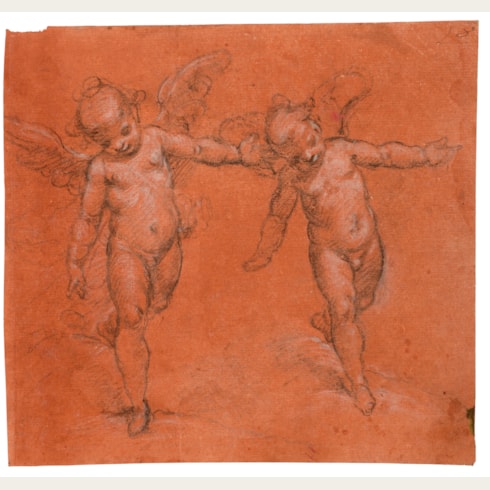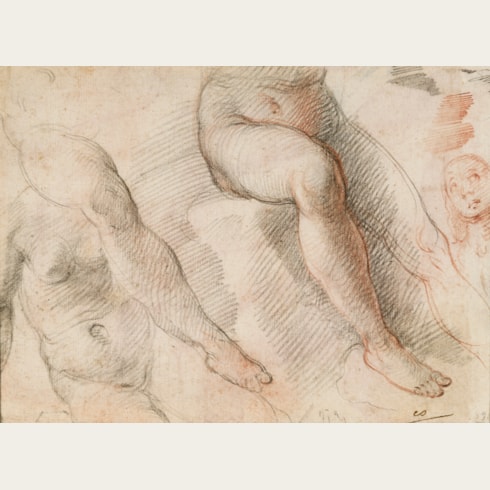Alessandro CASOLANI
(Mensano 1552 - Siena 1607)
Study of an Angel
Figure studies of a striding angel and a fragment of a Pietà drawn in red chalk on the verso.
156 x 99 mm. (6 1/8 x 3 7/8 in.)
Stylistically comparable drawings by Casolani include a red chalk study of an angel and a drawing of four playing putti, both in the Louvre, as well as a sheet of studies of two angels and the heads of three women in the Uffizi.
A similar study of a Pietà is found on a red chalk sheet of studies of Christ and a Pietà with angels, which was with Colnaghi in 1989.
Older than Francesco Vanni and Ventura Salimbeni, Alessandro Casolani shares with them an important position in Sienese painting of the late Mannerist period. As a youth, he befriended the artist Cristofano Roncalli and studied with him in Siena in the 1570s. He was trained in the studio of Arcangelo Salimbeni, and received his first independent commission in 1576, for a painting for a chapel in the Duomo in Siena. Casolani accompanied Roncalli to Rome in 1578, but was back in Siena by 1581. Among his works of this period in Siena is a large painting for the Oratorio di Santa Caterina in Fontebranda and an altarpiece of The Adoration of the Shepherds for the church of Santa Maria dei Servi. Religious works make up the bulk of Casolani's oeuvre, both in the form of church altarpieces and easel pictures for private patrons, as well as more elaborate projects, such as the decoration of the chapel of the Villa Bartalini at Monistero, near Siena. (He also provided designs for a series of chiaroscuro woodcuts of devotional subjects, executed by Andrea Andreani.) Casolani worked in and around Siena for most of his career, although between 1599 and 1600 he was in Pavia, where, at the behest of Cardinal Federico Borromeo, he contributed to the decoration of the Sagrestia Nuova of the Certosa, working alongside his fellow Sienese painter, Pietro Sorri. Casolani also remained closely associated with Vanni and Salimbeni, collaborating with the latter on the decoration of the Oratory of the Sienese church of Santissima Trinità with scenes from the Apocalypse.
As with his paintings, very few of Casolani's drawings have been published or exhibited. Nevertheless, he does not seem to have been as prolific a draughtsman as either Vanni or Salimbeni. This may have been because, as Flaminio Borghesi, Cardinal Leopoldo de' Medici's agent in Siena, noted of Casolani in a letter of 1673, 'by his very nature he was not (so they tell me) very fond of drawing, but instead made use of every little bit, correcting them and revising them as he painted.' With his distinctive, somewhat idiosyncratic style as a draughtsman, as Marco Ciampolini has noted, 'Casolani succeeded in creating a graphic language that was both very personal and powerfully striking. It was also a harsh style that was not greatly prized by collectors, who, nonetheless, grasped its importance...Moreover, his graphic art formed one of the fundamental strands of development in seventeenth-century Sienese drawing and lay at the basis of the production of Vincenzo and Francesco Rustici (respectively his brother-in-law and nephew), [Sebastiano] Folli, and Astolfo Petrazzi.'
According to the 17th century biographer Filippo Baldinucci, most of Casolani's drawings were inherited by his son Ilario, who was also an artist. The vast majority of his surviving drawings, like those of Vanni and Salimbeni, are today in the collection of the Biblioteca Comunale in Siena. Many other drawings by the artist are in the Uffizi (part of the collection formed by Leopoldo de' Medici) and the Louvre.
Provenance
Private collection.








